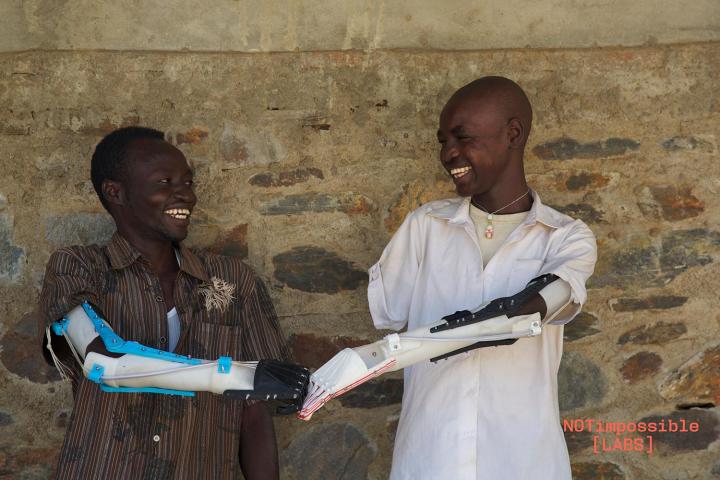
The answer, at least in the short term, is probably not all that much.
Most of the practical applications we’ve seen yield convenience more than anything else. The devices are surrogates for our smartphones, which, in most cases, we’ll have to continue to have on our person to get them to work.
3D printing has a number of industry changing advantages when it comes to prosthetic devices, but the biggest is also the most obvious: price.
The same might even be said for smartphones themselves. They’ve certainly made our lives more convenient with regards to communication, directions and innumerable other applications, but how many of us can honestly say that, aside from giving us something to do while we wait for the train, that they’ve significantly impacted our lives for the better?
But there’s another type of wearable technology designed very specifically to improve lives. Prosthetics have improved dramatically in the last few years — helped along in many cases helped along by the same technologies improving more pedestrian wearables.
If there’s one single most exciting technology pushing prosthetic innovation forward in the present era, it’s the same technology that seems to be revolutionizing just about every other field. 3D printing has a number of industry changing advantages when it comes to prosthetic devices, but the biggest is also the most obvious: price.
Remember that adorable video from a couple of weeks back where Robert Downey Jr. presents a small child with an Iron Man arm? You know, the one that you definitely didn’t cry over? The arm was created by Albert Manero, a University of Central Florida engineering student who is part of a growing group of individuals harnessing the power of 3D printing to change children’s lives.
Until the advent of mainstream 3D-printing technology, prosthesis was prohibitively expensive for many parents, given the rate at which their children were growing out of the devices. The tag team of 3D scanning and printing has reduced the cost dramatically, leading to the creation of several organizations like “Project Daniel,” which brings 3D printers to wartorn areas of Africa, such as the south Sudan, which is home to more than 50,000 amputees.
Smartphone technology is also improving prosthetics, though sometimes indirectly. For instance, the billion-dollar race to innovate has helped drop the price and size of high-tech components at a dramatic rate. A few years back, on a trip to Boston, Harvard’s resident robotic-hand expert told me how his team had unlocked the problem of low-cost pressure sensors by adopting tiny smartphone barometers.
Encased in some silicone, these weather-detection devices served as the perfect inexpensive electronic pressure sensor. All it takes is a little innovation to figure out how consumer electronic breakthroughs can be applied to such devices.
As it does so often these days, that innovation often arrives in the form of open-source projects like Open Hand (which, incidentally, also found a fair amount of its funds through Indiegogo crowdfunding) and exiii handiii, which has created a sub-$300 prosthetic hand. More interesting still is the fact that that project outsources its computation to a smartphone (no doubt a huge part of that slim price tag).
After all of the smartwatch talk and Samsung vs. Apple smack talk, technology truly does have the power to transform lives.
The device is, not surprisingly, also 3D printed. And while it has a number of built-in electronics, all of the heavy lifting is done by the wearer’s phone, which takes impulses from a user’s body and converts them into physical movement through the hand’s servos.
It probably goes without saying that these devices are a ways off from the multi-thousand-dollar devices being manufactured by more established companies. But it’s hard not to be excited by what they innovations mean for prosthetics at large, and more specifically for amputees who have formerly been unable to purchase such devices.
Of course, some incredible innovation is happening on the high end too. An artificial limb developed by Chalmers University in Sweden bypasses traditional muscle movement for neural control, allowing users to move the hand by thinking. Such a system makes for a more comfortable device and one that isn’t subject to electromagnetic interference.
And then there’s the team of researchers out of Cleveland, Ohio who have made added a sense of feeling to prosthetics by implanting electrodes that give the wearer the feeling of the object they are grasping. Wearers are able to recognize the object by touch and figure out the right amount of force to apply, without breaking it in the case of a fragile object like an egg or grape.
It’s the sort of thing that makes you misty-eyed, reading the account of a man who knew immediately that he was feeling a ball of cotton as soon as he tried the experimental technology. We’ve all seen the cochlear implant videos of small children hearing music for the first time and read the story of the 68-year-old man who saw his wife for the first time in a decade thanks to implants created by the Mayo clinic.
Sure, these videos are often clickbait tearjerkers, but the stories behind them are incredibly important. They’re reminders that at the end of the day, after all of the smartwatch talk and Samsung vs. Apple smack talk, technology truly does have the power to transform lives.
Editors' Recommendations
- Fossil’s first Wear OS 3 smartwatch looks like a better (and cheaper) Pixel Watch
- iPhone rumor says 2019 models will make 3D Touch a thing of the past


